Life and Death in the films of George A. Romero
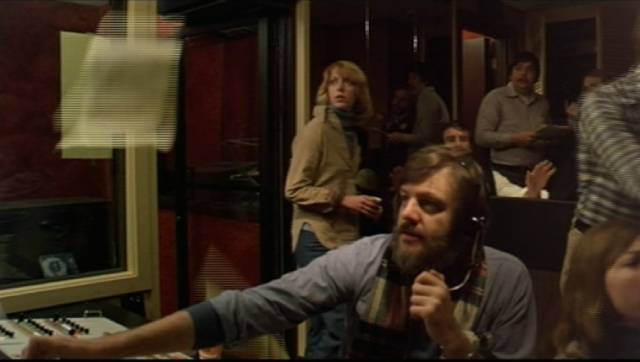
It’s been a long time coming, but now that it’s here, it was worth the wait. Anchor Bay released their four-disk Ultimate Edition of George A. Romero’s Dawn of the Dead (1979) back in 2004. It included all three cuts of the film – the 127-minute theatrical, the 139-minute extended, and the 118-minute Dario Argento cut – plus a disk of extras, including the original 66-minute version of Roy Frumkes’ making-of Document of the Dead (1980). For a fan it didn’t get any better than that. But time moved on, technology advanced, and even the most obscure low-budget exploitation movies were being restored and released on Blu-ray. Where was Romero’s epic genre-defining masterpiece in all this?
Well, it’s been sixteen years and we now have an answer. (There was a set released several years ago by Koch in Germany, but reviews were problematic and it gave centre stage to the Argento cut.) On November 16, Second Sight in England released a limited edition set in both 4K UHD and Blu-ray editions – and, yes, I did briefly contemplate upgrading my TV and player before reason stepped in and prevented me sliding down that rabbit hole. There was a stumbling block, though; Second Sight only has the UK rights and is prohibited from selling the set outside UK borders. So I tried Amazon UK and was blocked there too. In the end, I had to have it shipped to a friend who lives in London and he mailed it on to me in Canada – so does that make me a smuggler?
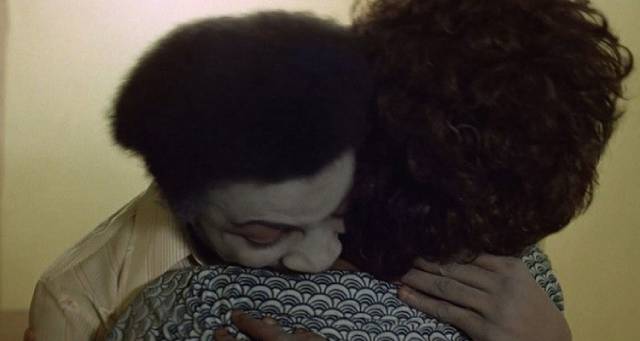
Without question this set is the release of the year. Each version gets a 4K restoration on its own disk, with Anchor Bay’s commentary tracks ported over, plus a new track with Travis Crawford on the theatrical cut. Then there’s a fourth Blu-ray of extras – most of Anchor Bay’s featurettes, plus both versions of Frumkes’ documentary, and a heap of new documentaries and featurettes – totalling almost seven hours. In addition, there are three CDs, one with Goblin’s iconic score and two with a huge selection of library tracks used at some point in one version or another. There’s also a 160-page hardcover book of new and archival essays and articles, plus a paperback of the novelization by Romero and Susanna Sparrow (which I used to own in hardcover from the Science Fiction Book Club). Opening the box, it felt like Christmas arriving early.
If the overstuffed package is a big draw, the reason Romero fans will embrace this set is the superb restorations of the three different cuts. Despite having been shot on a relatively small budget, Dawn of the Dead is an impressive achievement thanks to Romero’s considerable skills as writer, director and editor. Michael Gornick’s camera is always as dynamically engaged with the action as it is attentive to quieter moments. It’s a remarkable accomplishment in world-building – if Night of the Living Dead (1968) set down the rules for the zombie genre, Dawn defines the apocalyptic social, political and psychological contexts which are now taken for granted by anyone looking to delve into zombie-dom – from low-budget independents like Marc Price’s Colin (2008) to Kiah Roache-Turner’s Wyrmwood (2014) to Edgar Wright’s Shaun of the Dead (2004) and on to the various Walking Dead franchises.
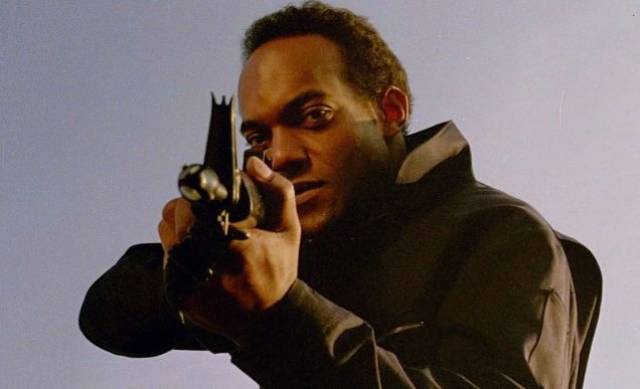
Night was born out of the political chaos of the late 1960s, bringing the horrors of the Vietnam War and racial violence back to home ground and leaving ordinary people to fend for themselves. A decade later, with the war historically if not psychologically in the past, the horror comes to reside in the ways consumer capitalism is rapidly redefining how people see themselves and each other. Night was horror at its purest; Dawn is satire at its most horrific. Romero related in interviews that he had no desire to do a sequel to Night despite considerable pressure from fans and potential backers … until, that is, an acquaintance introduced him to the newly developed Monroeville Mall, a vast shopping complex near Pittsburgh which triggered his filmmaker’s imagination with visual and narrative possibilities.
He had already begun working on a story when he was contacted by Dario Argento, who was interested in working with him … the rest, as they say, is history. With Argento on board as a co-producer (who would retain European distribution rights as well as bringing Goblin onto the project), the production came together. What seems most remarkable in retrospect is that Romero obtained permission to film inside the Mall. It’s impossible to imagine any company okaying that kind of mayhem inside their commercial property today – let alone conceiving how the crew were able to film large-scale destructive action sequences with crowds of zombies, speeding bikers, gunfire and blood spatters through the night and restore everything to its pristine state in time for the next morning’s regular business. It no doubt helped that the production was working far from Hollywood where people had less experience of film crews, but still it’s an amazing spectacle.
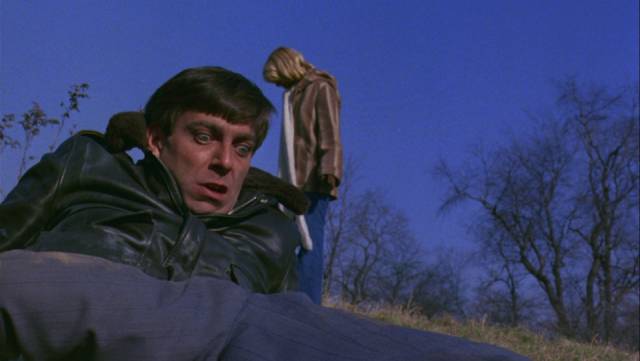
One of Romero’s enduring characteristics is that he throws his audience into the middle of chaos, immediately creating a sense of disorientation which establishes a level of unease sustained through the rest of the film, undermining every subsequent moment of seeming calm. Romero’s world is one in which ordinary people barely stand a chance; chaos looms and the supposed forces of order and control not only fail to stand against the tide of chaos, they inevitably make things worse. The deepest levels of horror in his work are where human beings abjectly fail to create a positive, supportive society in which we could all survive in reasonable comfort despite the implacable disinterest of the universe. In Romero’s films, we always end up destroying ourselves because we fail to understand, we fail to do what we really need to in order to survive.
At the beginning of Dawn, order has already collapsed. The pointless activity in the television station – a host arguing with an official trying to explain what’s happening, the station manager who’s worried about losing viewers, the few who try to hang on to a sense of responsibility by not running a list of rescue stations which no longer exist – cuts to a SWAT assault on a housing project where the residents refuse to give up their dead relatives. The cops, themselves terrified, turn on the living, indiscriminately shooting their way through the building in the name of restoring order.
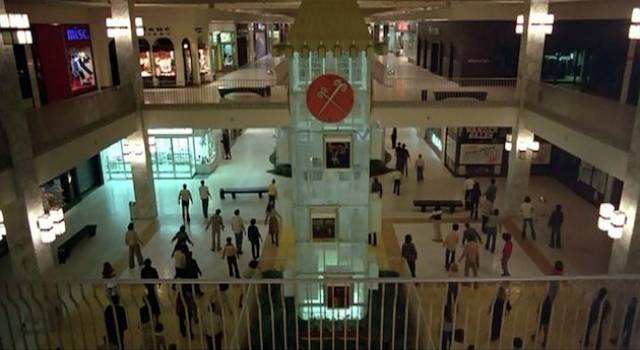
Watching Dawn of the Dead again in our current context, it’s startling to see a previously unnoticed prescience. The reactions to the zombie plague now appear as an only slightly exaggerated reflection of attitudes to the pandemic and protests against police violence – denial of reality, rejection of science and reason in order to cling to convictions about the way things are supposed to be rather than how they actually are. Not to mention the drift towards the “forces of law and order” beginning to wage war on the people who no longer accept their authority.
After the violent chaos of the opening act, the film slips into a different rhythm when the four protagonists – TV station employees Fran (Gaylen Ross) and traffic ’copter pilot Stephen (David Emgee) and SWAT team members Roger (Scott H. Reiniger) and Peter (Ken Foree) – arrive at the Mall. At first just pausing on their flight from the city, they feel the pull of this consumer paradise, just as the dead do. They take risks to secure the huge building and clear out the dead who wander mindlessly among the fully-stocked stores; and they gradually establish a home in rooms above the stores, bringing in supplies and eventually furniture and decorations.
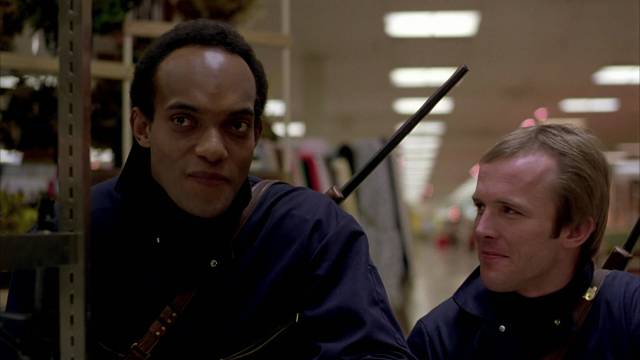
Isolated from the chaos in the outside world – though constantly reminded of it by the zombies banging on the Mall doors and shuffling aimlessly around the parking lot – it turns out they have little in the way of inner resources to fall back on. Peter, initially the toughest, most independent of the quartet, is forced to dispatch Roger when he dies of his injuries and comes back. Now he’s a spare wheel as Fran, who is pregnant, and Stephen more or less set up house. But this tentative family unit proves unsustainable. Fran gains inner strength, realizing that she must be able to take care of herself – she learns to shoot, she insists on being trained to fly the helicopter – and the more independent she becomes, the more resentful and angry Stephen becomes; her independence is a direct challenge to his sense of himself as a man.
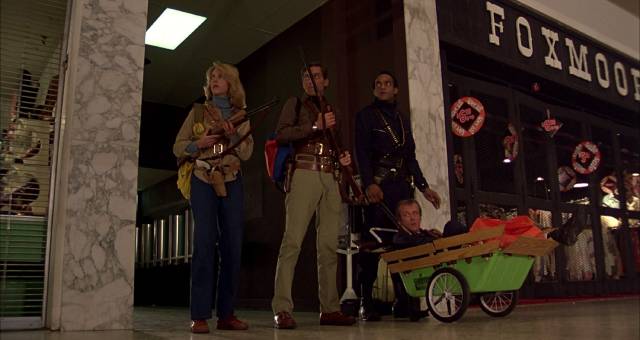
When a large party of raiders arrive, rather than heeding Peter’s advice that they just lay low and let the bikers loot and fight the zombies they let back into the Mall, just wait until they move on, Stephen, deprived of his role as Fran’s protector, decides to fight back for what he sees as his property. The war he starts makes things worse, leading to the complete destruction of the haven they’ve built for themselves and the loss of his own life. Apparently Romero had originally intended that everyone die, as they had in Night of the Living Dead, but he relented .. well, just a bit. Fran can fly the helicopter and Peter decides that maybe it’s not quite time to die yet, but there’s very little gas and the world out there is overrun with the dead … not a lot to hope for, but at least they’re still alive for the moment.
Romero despairs for our ability to do the right thing, but he leaves a small opening for the possibility. Both Roger and Stephen were unable to deal with the chaos, but Fran and Peter won’t give up even if it does seem hopeless, and Romero finds that admirable rather than ridiculous. If their attempt to cling to an illusory consumer paradise has proved to be a dead end, they are both capable perhaps of finding a more viable alternative.
*
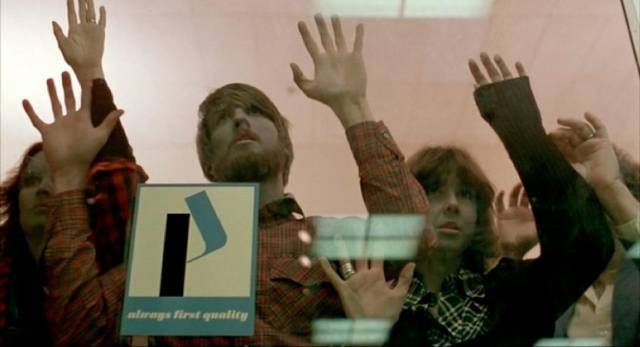
There are numerous minor and quite a few major differences between the three versions of Dawn of the Dead. Each has elements unique to that version and within sequences there are variations in editing, sound, music. The longest version, sometimes mistakenly referred to as a “director’s cut”, was put together under a deadline to be ready for a premiere at Cannes. Romero continued to work on it after that screening and the theatrical cut was his preferred version. Argento shortened and rearranged the film for the version distributed in Europe, retitled Zombi. Although there is some of Goblin’s music in the Cannes cut, much of the film is scored with library tracks. There is some library music in the theatrical release, but much more Goblin, and Argento pretty much smothered his cut under Goblin’s music.
Don’t get me wrong, I love Goblin’s score, but Argento used it indiscriminately, trying to pump every scene up to give the impression of non-stop breathless action; the results actually tend to flatten the movie because it destroys Romero’s deliberate variations in rhythm – where both of Romero’s versions alternate action and calm and in many sequences use natural sound to heighten tension, Argento’s version always seems to be yelling at the audience. It becomes tiresome.
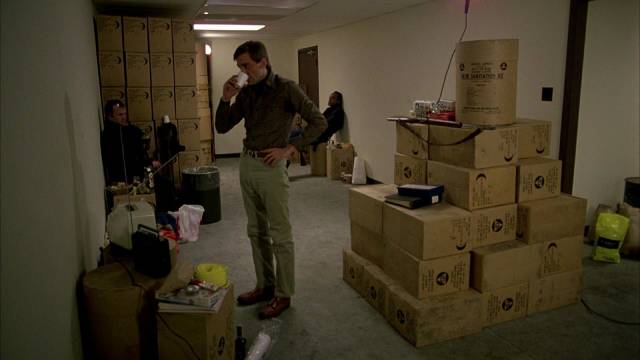
Strangely, at the same time, Argento chops out crucial pieces of action. Sometimes it’s small details that flesh out a scene, but sometimes it’s something major and it’s hard to see why it was done other than to bring down the length. This is perhaps most noticeable when Peter, Roger and Stephen set out to seal up the Mall doors with trucks from a nearby depot. In the original film, this is a two-part sequence – the first truck goes well and Roger gets pumped up with adrenaline from the danger and excitement; this makes him overconfident and careless, leading to the bites which eventually kill him. Argento cuts out the entire front end of the sequence, dropping the first truck and Roger’s escalating mania. Instead, he cuts straight to the second truck with Roger inexplicably behaving like a maniac. Romero’s thoughtful treatment of the psychological effects of danger on the characters – particularly Peter and Roger – is completely thrown away. But this is not like trimming some of the quieter character-building moments; what’s cut is one of the film’s most exciting set-pieces.
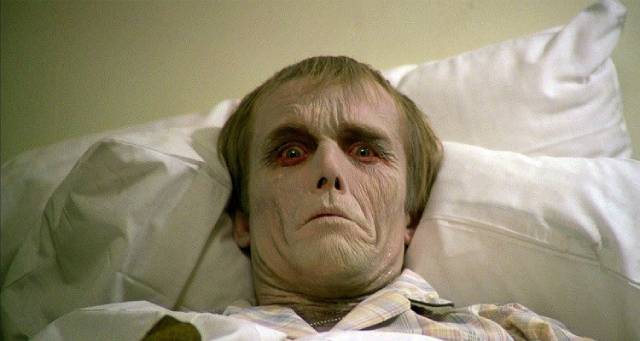
Needless to say, the Argento cut is my least favourite. Romero notwithstanding, I actually like the longer Cannes cut best. If I’d never seen it, I probably wouldn’t miss it, but now I find there are a few things that seem a bit rushed in the theatrical cut where in the long version moments are allowed to play out more satisfyingly. I also miss the sequence at the police dock where Fran and Stephen stop to gas up the ’copter and run into a group of cops who are also planning to escape by boat. It may not be narratively vital, but it reinforces the collapse-of-authority theme – these cops, like Fran and Stephen, are now looters, abandoning normal constraints in their determination to survive. There’s a moment of tension in which they have to assess each other; recognizing that they share the same purpose and that rules no longer apply, they all go on their relative ways hoping there’s somewhere to find sanctuary.
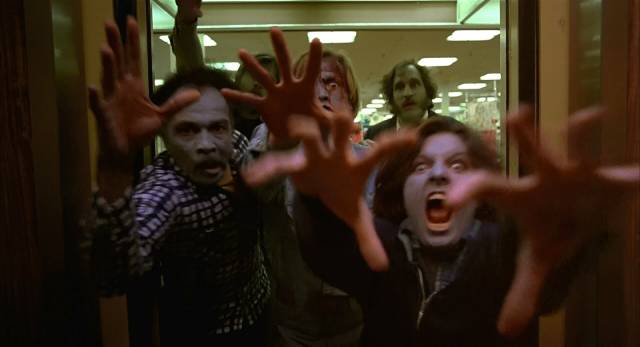
Although Romero trimmed this for his own preferred cut, Argento removes it completely. I bring it up mostly because it’s this kind of textural detail that distinguishes Romero from so many other genre filmmakers. He has a great story sense, but also having been an editor (and in fact editing many of his features), he fills his canvas with details which greatly enrich the narrative. There’s a density to his work which gives you the sense of a living, breathing world, while amplifying the excitement of the action and the authenticity of the characters. His filmmaking skills immerse you in the world he’s imagined; you feel that world extending far beyond the parts you’re seeing. This is what gives the various chapters of his zombie apocalypse their epic sense of scale.
*
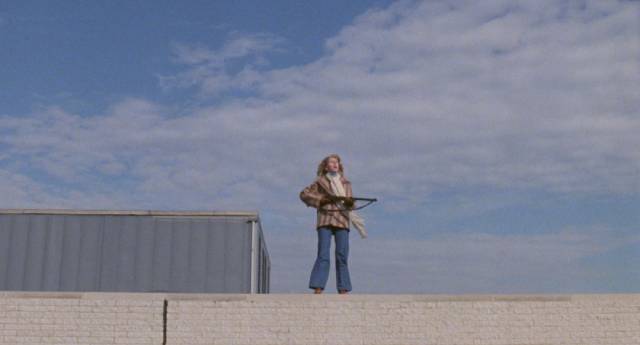
Maybe it’s being an editor myself that makes me so aware of Romero’s use of editing, though I was already responding to his work before I became an editor. Although he’s quite capable of staging big scenes, it’s his use of an accumulation of details to build scenes that gives his work its distinctive energy – he has a wonderful sense of telling details, of meaningful movement from image to image. His themes are embedded in the editing, and it’s his confidence in this skill which allows him to fill his work with social and psychological significance without having to spell things out.
Issues of race and gender run through his work without ever falling back on didactic statements. It’s a well-known fact that the racial element of Night of the Living Dead was almost accidental; the character of Ben had no specified characteristics in the script and Duane Jones was cast because he was the best actor to audition. It was the actor who transformed Ben from a fairly coarse working class guy into a more intellectual character, a man who can command because of self-assurance and an ability to argue forcefully. And yet those strengths aren’t idealized, because as events play out Ben, with all his reason, turns out to be wrong about just about everything. The plans he sets in motion end up getting everyone, including himself, killed.
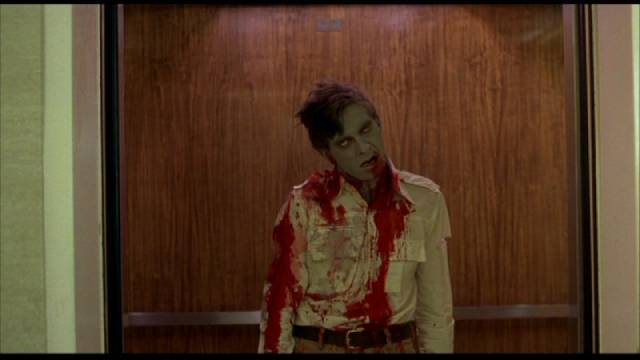
In Dawn of the Dead, there’s nothing forced about the positioning of the characters, but Romero skilfully establishes that Stephen and Roger are weakened by their unspoken privilege as white guys, while Fran and Peter who have had to assert themselves against resistance and prejudice long before the advent of the zombie apocalypse turn out to be more resilient and better able to deal with the chaos and danger they all now confront. Fran is the culmination of a development running through Romero’s work up to that time; in retrospect, he was critical of Barbara in Night of the Living Dead, although her rapid descent into catatonia is entirely plausible given the trauma she has endured. The reading of her character as some archetypally “weak woman” is not entirely valid in the narrative context, but it does raise echoes of too many ineffectual women in horror film history.
In his two subsequent films – There’s Always Vanilla (1971) and Season of the Witch (1972) – the female characters fare better, their limitations a function of their social conditions rather than ascribed to something intrinsic in “the female”. Fran is simply functioning on an even footing with the other characters, and in fact turns out to be stronger and more mature than Stephen, who eventually reverts to a pouting boy whose feelings are hurt because she doesn’t actually need him to protect her. There are equally strong women in the subsequent films exploring the social disintegration brought on by the zombie apocalypse, particularly Lori Cardille’s Sarah in Day of the Dead (1985).
*
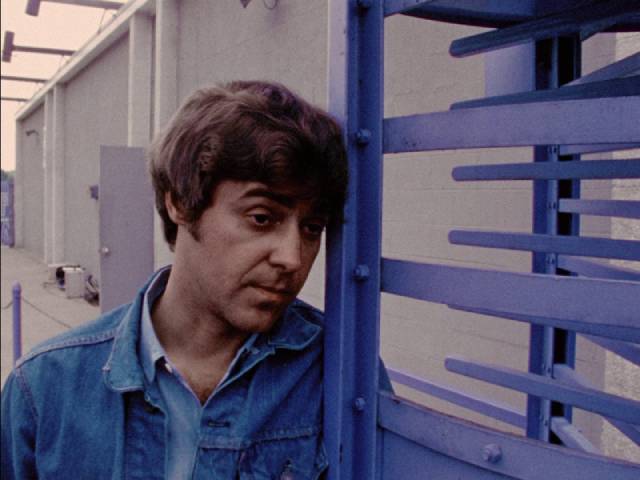
Having immersed myself in the world of Dawn of the Dead, I finally got around to Arrow’s George A. Romero: Between Night and Dawn box set, which has been sitting on a shelf untouched for three years. It was released in 2017 just after Romero died and I’m not sure why I didn’t watch the three early films it contains back then. I’d occasionally notice it there on the shelf and remind myself that I should take a look, but always chose something else. Whatever the obscure reluctance might have been, it was revisiting Dawn that finally prompted me, and this turned out to be a good moment to observe again Romero’s experiments as he forged his identity as a filmmaker. The three films in the set were made partly in response to the critical and commercial reaction to Night.
Because of the notorious pitfalls of film distribution, Romero and his collaborators saw almost nothing from the surprise box office success of their first feature, while the movie itself quickly gained notoriety from attacks by critics – most notably Roger Ebert’s absurd rant which was actually reprinted in Reader’s Digest, failing to see what the movie was doing because he’d watched it at a matinee full of little kids who were traumatized by horrors which were all too real rather than absurdly camp. Ebert attacked the motives of the filmmakers rather than the parents who’d dropped their kids off without any idea what they were going to see. You also have to wonder what the management were thinking, letting little kids in to see it. What all this really pointed to was just how monumental a game changer Night was – horror was generally seen as a joke, something for kids, but Romero had made a film for adults with adult themes.
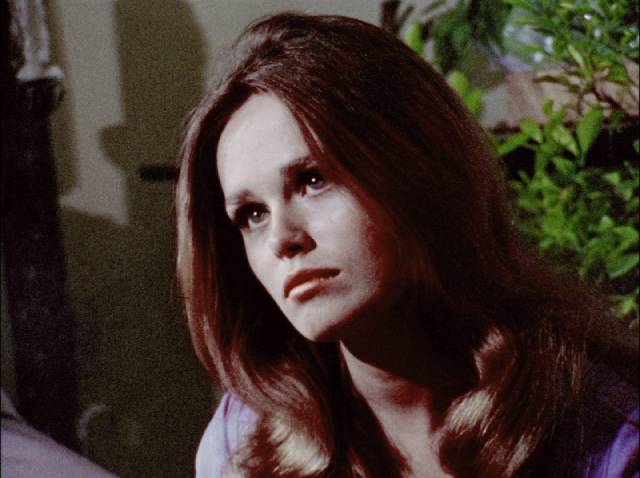
Not wanting to be pigeonholed as a horror filmmaker, and wanting to move on quickly from the bitter experience of seeing his first movie taken away from him, Romero went in a completely different direction for his follow-up. This time he wasn’t involved in the writing, taking on a script from one of his Latent Image colleagues, Rudy Ricci. There’s Always Vanilla bears a superficial resemblance to romantic comedies like The Graduate and Goodbye, Columbus, but stylistically it draws more on European than Hollywood models, deconstructing the genre as it explores the fallout of ’60s social change on relationships.
Chris Bradley (Ray Laine) wants to be a musician, but he’s sick of just being a session player on other people’s records. So he walks away and returns to his hometown, Pittsburgh, where he reconnects with a former girlfriend who has a young son who may or may not be Chris’s. He also reconnects with his father (whom he immediately hooks up with a dancer to get laid). He doesn’t want to go back to school, but doesn’t really have any ideas about what to do with his life. The idea of taking on traditional responsibilities (that son) doesn’t appeal to him, and he clings to immaturity, trying to maintain that state between childhood and adulthood – despite the fact he was in the army in Vietnam and has spent time working in the music industry.
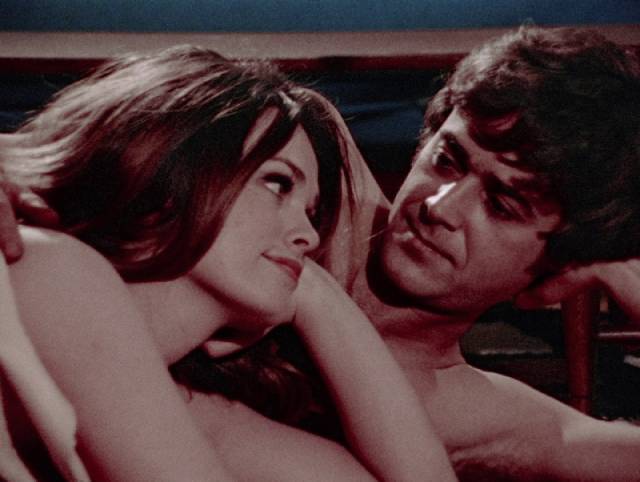
He meets cute with Lynn Harris (Judith Streiner, who as Judith Ridley had played Judy in Night of the Living Dead), and after initial antagonism they end up together. She’s a model who’s developing a career in TV commercials, where she has to deal with sleazy types who expect sexual favours and, on the job, treat her as a piece of meat to be manipulated. Chris’s easy-going, initially undemanding charm is a refreshing contrast. But his resistance to responsibility begins to wear on her.
He lands a job at a big ad agency by confidently bullshitting his way through the interview – but he has no interest in the job; it’s a performative gesture to expose just how phony that world is, a truism illustrated by Lynn’s own experiences selling toilet bowl cleaner. His brashness, comparing advertising to pimping, makes the company executives think he’s just the thing they need to sell shit to the kids. But when his first task is to sell those kids on the idea of joining the army, he quits in disgust. (Given that Romero and his collaborators made their living by producing television commercials at their company, The Latent Image, he’s extremely forthright about his contempt for the advertising business.)
So Chris buys a typewriter and declares he’s going to write a novel. When Lynn asks what it’s about, he says he doesn’t know yet. He’s looking for a role to validate who he thinks he is rather than an actual life. She gets tired of him and when he arrives at her apartment one day, it’s been stripped bare and the guy painting the walls says he doesn’t know where she’s gone. The relationship is over without ever really having begun.
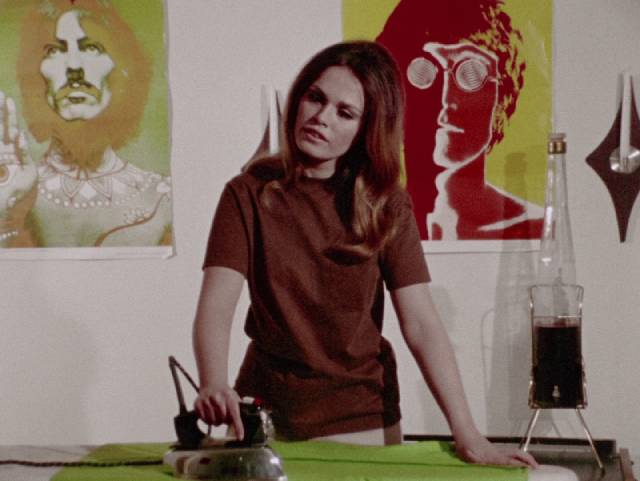
Coming at the end of the ’60s, There’s Always Vanilla wonders where that decade’s energy and sense of commitment have gone, and whether it wasn’t just an illusion all along. For what looks superficially like a romantic comedy, it’s pessimistic about romance between people who have no sense of purpose.
Romero himself was dissatisfied with the film; as with the one which followed it, he had too little time and money to do everything he wanted to do, and it was made at a time in flux which meant that when it was released it already seemed out-of-date – particularly in a disturbing sequence in which Lynn, without telling Chris, goes for a backroom abortion which takes on a sinister atmosphere, a scene made anachronistic by the Roe v Wade decision which came between production and release.
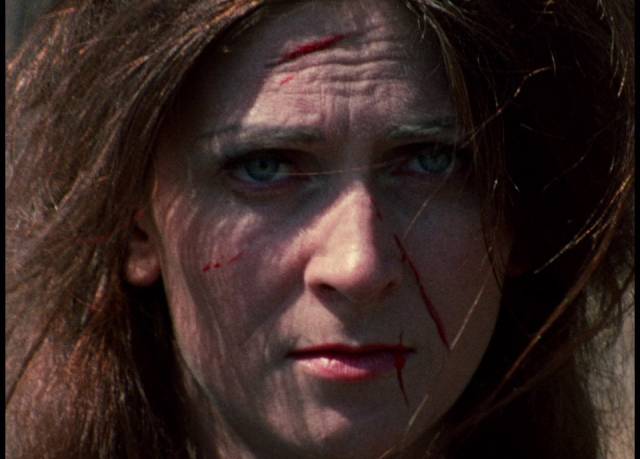
Joan Mitchell (Jan White) feels her identity being erased
But this illustrates two points: an artist’s view of their own work is only tangentially relevant to a viewer’s response to the work and details specific to the time of production matter less when watching a film years later. Now it’s easier to appreciate it as a reflection of that period in the past rather than something quickly made irrelevant by the flow of events. As a time capsule, There’s Always Vanilla illuminates the collapse of idealistic engagement at the end of the ’60s. It also shows both Romero’s versatility and his consistency; it depicts characters in a crisis of self-definition which may not be as extreme as the crisis in Night, but is nonetheless vital. In Night the question is how to survive; in Vanilla how to create a livable life.
Romero works well with his actors and again builds scenes through an accumulation of physical and behavioural details edited to produce thematic resonance and a sense of inexorable momentum which sweeps the characters along, leaving them with little time to work out what they think and what they need to do.
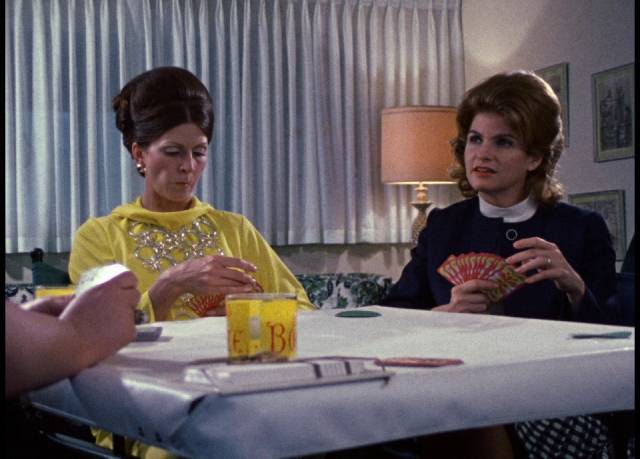
This quest for self-definition is the primary dramatic and thematic substance of Romero’s next film, Season of the Witch, working this time from his own script. Here he goes even further against the Hollywood grain, using numerous dream/fantasy sequences to illuminate the mental state of suburban housewife Joan Mitchell (Jan White), beginning with a long, disorienting sequence in which she follows her husband Jack (Bill Thunhurst) along a woodland path; he is oblivious of her, his face buried in a newspaper as he walks, while she sees a series of signifiers which point towards the roots of her dissatisfaction. Serving him coffee, seeing a child demanding her attention, being whipped in the face by branches he carelessly releases in front of her, even seeing a younger more carefree version of herself on a swing hanging from a tree branch; eventually Jack puts her on a leash and takes her to a boarding kennel where she’s left in a cage as he prepares to leave on a business trip.
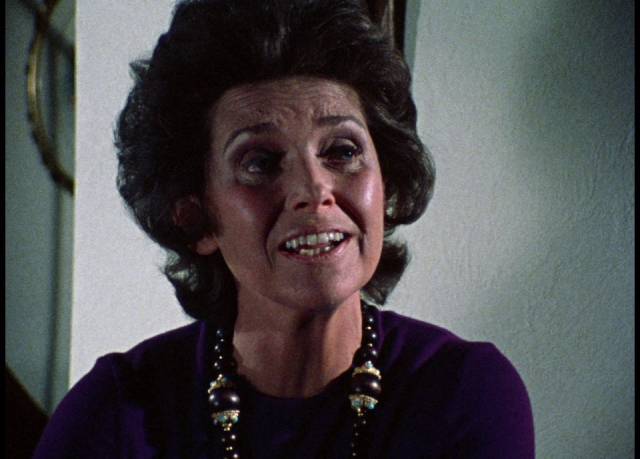
Joan has everything a middle class woman is supposed to want, the big house, the husband who earns a substantial living, a busy social life – parties, cards with her friends. But there’s no emotional connection with husband Jack or daughter Nikki (Joedda McClain). Like those who settle down in the Mall in Dawn of the Dead, she has everything and yet nothing. When a friend introduces her to a witch – a woman who reads Tarot cards – Joan finds something which promises a sense of purpose and meaning. She buys books and paraphernalia for casting spells, although a part of her is frightened by the idea of gaining a power which may be hard to control.
This new interest creates cracks in her overly ordered life, cracks through which Gregg (Ray Laine again) enters. A college teacher with a certainty that he’s on top of things, he has contempt for women like Joan and her friend Shirley (Ann Muffly), whom he sees as uptight phonies – in fact, he goes so far as to say that such women are the root of society’s problems. He has a casual sexual relationship with Nikki, which scares and disturbs Joan. When Nikki realizes that Joan has come home early and overheard her and Gregg having vigorous sex, Nikki packs and leaves home. (Jack blames Joan and hits her.)
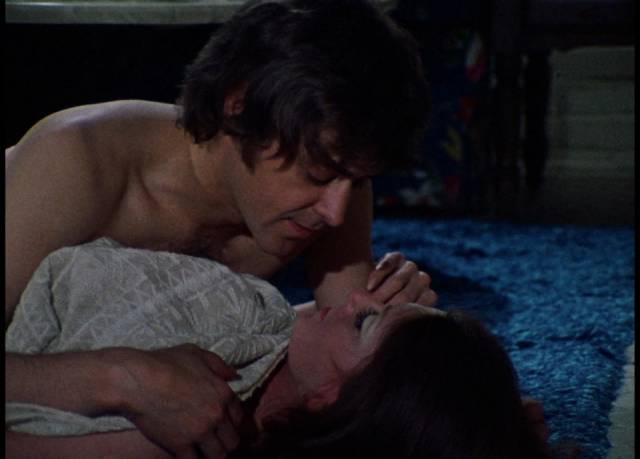
The first spell Joan casts is to have Gregg come to her. After casting the spell, she phones him to invite him over and he comes; she tells herself that this is in response to the spell, rather than her invitation. As Romero put it, this displaces her own desire onto some external supernatural force. When he shows up, she feels a stirring of power, though having sex with his casual girlfriend’s mother is something he’d do willingly without prompting – Gregg’s smug sense of entitlement is completely open as he mockingly calls Joan “Mrs. Robinson”, labelling her a sexually predatory older woman while taking advantage of her for his own amusement. Yet even as she feels exhilarated by her sense of newfound power, Joan has increasingly disturbing dreams in which a demonic entity lays siege to her home, seeming to threaten violence, although his mask calls to mind the Green Man, a pagan symbol of nature’s fecundity, so perhaps a manifestation of Joan’s own awakened sexual desire which she feels is beyond her control. These dreams reach a climax when Jack returns early from a business trip, his fumbling at the front door blending with the demon’s attempts to get in, and Joan blasts him through the door with a shotgun.
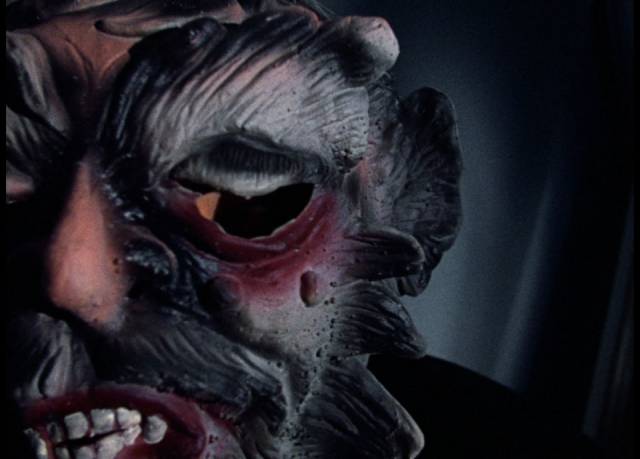
Freed from Jack and with Nikki gone, Joan has gained confidence in her own power and resumes her life envied by her friends who are still encumbered by their own material and marital constraints. Made as the feminist movement was calling into question every aspect of women’s lives, redefining their social, economic and sexual circumstances, the film problematizes Joan’s hesitant steps towards liberation – the power she gains is rooted in mystical delusions, substituting one set of beliefs for another, both constraining in their own way. Although Jack’s death is ruled an accident, she nonetheless had to eject him from her life violently rather than merely removing herself from the marriage; by killing him, she retains all the material security he provided – she doesn’t reject her middle class privilege in favour of an alternate way of life. And yet throughout Joan remains a sympathetic character, her efforts to redefine herself something easy to identify with.
Jan White, beginning with a fairly brittle performance, grows progressively warmer and more appealing as things progress. If the film has a weakness, it may be that the men – Jack and Gregg – are somewhat exaggerated as chauvinistic, insensitive jerks. How could the viewer not be on Joan’s side even when she kills Jack? – though it’s not at all certain that she didn’t actually intend to.
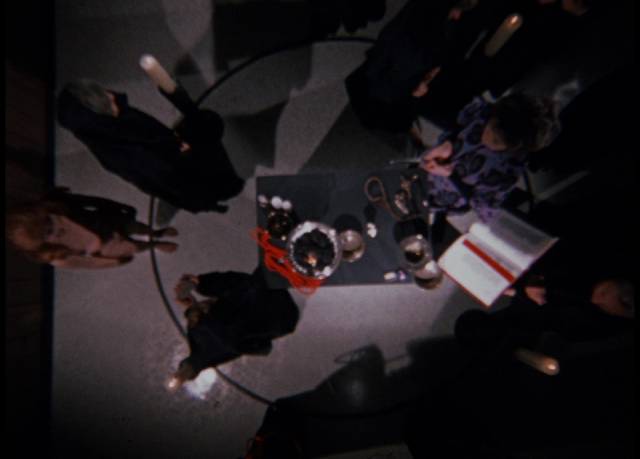
Neither There’s Always Vanilla nor Season of the Witch made much of a mark, both hampered by a distributor who tried to frame them as softcore porn (they were retitled, respectively, The Affair and Hungry Wives), disappointing those who might have gone looking for some vicarious stimulation while keeping a possibly more sympathetic audience away. Season of the Witch, originally Jack’s Wife, was the most damaged by these circumstances; the distributor reportedly cut forty minutes from Romero’s original 130-minute cut. Somehow a 104-minute version turned up on home video, and Arrow include this as a supplement, inserting SD sections into their restoration. The extra material mostly consists of expanded sequences which add more detail to discussions of the state of middle-class life and the occult. In later interviews, Romero was fairly dismissive of both films, though they now appear interesting and to some degree successful expressions of social currents active at the time they were made and, in retrospect, show Romero refining his filmmaking skills.
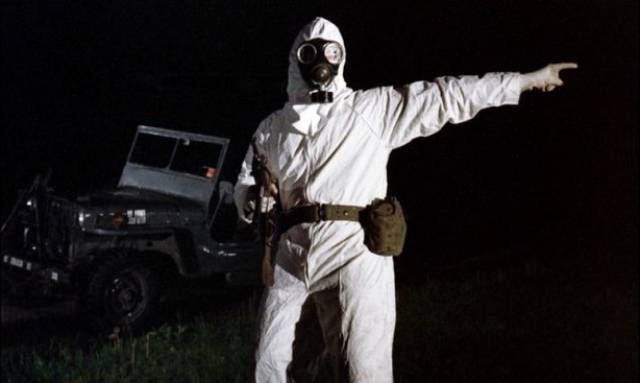
With neither film having anywhere near the impact of Night of the Living Dead, Romero next made a choice to return to horror despite his reluctance to be typecast. Conceived on a larger scale than Night, The Crazies (1973) is considered by some to be a kind of practice run for Dawn of the Dead, though it’s really quite different in many ways. Night remains something of a chamber piece, limited to the experience of the people who seek shelter in the farmhouse; the wider picture reaches us only through television reports. In The Crazies, we get a small group of characters trying to escape the horror, but Romero depicts in detail the actions of the authorities – a committee of politicians in some distant, secure location making sweeping decisions, and the military on the ground carrying out those decisions without regard for the lives of thousands of people caught in a crisis actually created by those same authorities.
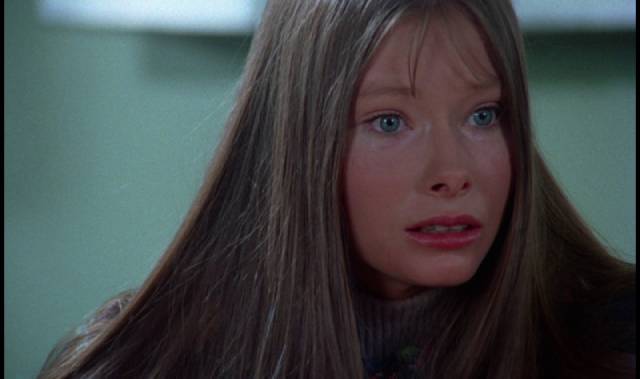
Romero drops us immediately into disorienting violence. Two young children see their father go mad, smashing up their house, having already murdered their mother in her sleep. He sets fire to the house and both children are seriously injured. As the volunteer fire brigade rushes to deal with the blaze, military vehicles and soldiers dressed in biohazard suits are seen gradually taking charge of the town. They set up a command centre in the local doctor’s office, where the two children are brought. The doctor and the mayor, it turns out, already have some idea of what is going on, having been informed a week earlier that a plane had crashed near the town carrying an experimental “vaccine”. Turns out that this cover story had been used to conceal something far worse and that the authorities had stupidly just hoped they could get away with doing nothing.
What the plane had been carrying was an engineered virus, code name Trixie (Romero’s original title), research on which had been abandoned several years earlier because it was too dangerous and there was no apparent cure. The virus either kills quickly or unleashes psychotic violence in those infected, and it’s clear that it has spread through the town and surrounding area in the water supply. The town is sealed under military quarantine, though with a week already wasted there’s no guarantee it hasn’t already been spread elsewhere by people who have passed through.
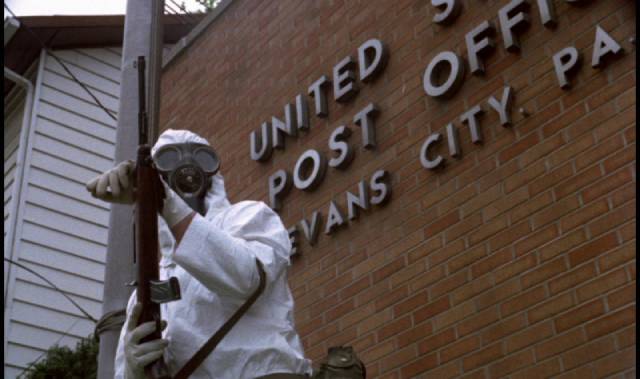
The response of the authorities, belatedly reactivating the Trixie team to try and find a cure or vaccine while trying to control an increasingly panicked population with brute force, escalates the chaos. The nature of the disease makes it difficult to tell whether someone is infected or just angry or terrified – some people object to the sudden imposition of martial law and take out their guns to resist, others fight back because they’re infected. The soldiers, who themselves haven’t been told what’s really happening, find themselves brutalizing and killing ordinary Americans. Romero fills the movie with violent vignettes which reveal how vulnerable everyone is when the normal rules of social behaviour are swept away … this is the clearest precursor in the film to what is seen on an even larger scale in Dawn of the Dead.
While the authorities mishandle the situation and make things increasingly worse, a small group of townspeople – a couple of volunteer firefighters, David (Will MacMillan) and his buddy Clank (Harold Wayne Jones), both with military experience from their time in Vietnam, David’s pregnant girlfriend Judy (Lane Carroll), Artie (Richard Liberty), a widower, and his teenage daughter Kathy (Lynn Lowry) – attempt to break out of the military cordon around the town. As they run and hide and occasionally fight, one by one they succumb to the virus – all except one who appears to have a natural immunity, something the Trixie scientists working in the high school lab are desperately trying to find. But by the time he is captured, all order has broken down and his immunity will never be discovered as reports that the virus has shown up in a bigger city come in.
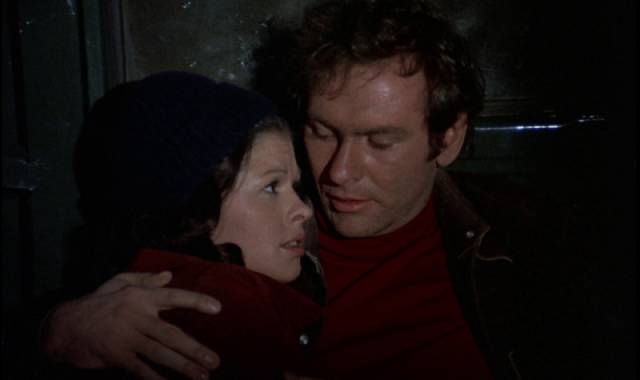
In Night of the Living Dead, the origins of the zombie plague remain unknown (suggestions of radiation from space remain mere speculation). In The Crazies, the horror is firmly rooted in human stupidity, our capacity to invent dangerous things over which we have absolutely no control. Rather than deal with the outbreak in a rational, considered way, the authorities panic and act to conceal their own responsibility, making things worse as they try to escape blame. Ordinary people are their victims, desperately trying to survive, but powerless to save themselves from what’s been done to them by those whose role is supposedly to protect the population from outside threats. Tense and relentless, The Crazies is probably Romero’s most pessimistic movie.
*
Each film in the set gets a Travis Crawford commentary plus interviews and featurettes. There’s also a booklet with an interesting essay on each film by, respectively, Kat Ellinger, Kier-la Janisse and Heather Drain.
*
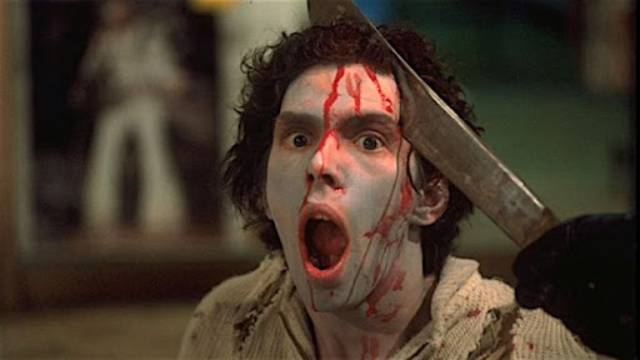
Arrow’s three-disk set fills in an important period in George A. Romero’s development as a filmmaker and the evolution of key themes which run through his work, but it’s not complete. Despite the overall title – Between Night and Dawn – it omits not only the most important film from this period, but what remains Romero’s absolute masterpiece: Martin (1977). That omission remains unexplained, though at the time the set was released I hoped it signalled an impending stand-alone special edition release. But three years later, it still hasn’t shown up. Martin has only received a string of problematic DVD releases since Anchor Bay’s original disk came out in 2000. Given the quality of Second Sight’s Dawn of the Dead set, we can only hope they’ll soon turn their attention to the best film Romero ever made. (That edition finally came in 2023.)
Comments